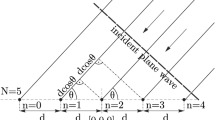Abstract
In this paper we consider a class of geometric methods for acoustic source localization based on range differences (or time differences of arrival), and we offer a new and unifying perspective on such methods based on the adoption of a multidimensional reference frame obtained by adding the range difference coordinate to the spatial coordinates of the source. In this extended coordinate system the working principles of a wide range of source localization methods becomes clear and immediate. The space–range reference frame, however, has a practical purpose as well, as it can be used for gaining insight on why some configurations of microphones lead to better localization performance than others and it suggests methods for improving existing localization techniques. In particular, we derive a closed-form solution of the constrained least-squares localization problem for linear arrays of microphones.















Similar content being viewed by others
References
Abel, J. & Smith, J. (1987). The spherical interpolation method for closed-form passive source localization using range difference measurements. In Acoustics, speech, and signal processing, IEEE international conference on ICASSP ’87 (vol. 12, apr pp. 471–474).
Beck, A., Stoica, P., & Li, J. (2008). Exact and approximate solutions of source localization problems. IEEE Transactions on Signal Processing, 56(5), 1770–1778.
Compagnoni, M., Bestagini, P., Antonacci, F., Sarti, A., & Tubaro, S. (2012). Localization of acoustic sources through the fitting of propagation cones using multiple independent arrays. IEEE Transactions on Audio, Speech, and Language Processing, 20(7), 1964–1975.
Gillette, M., & Silverman, H. (2008). A linear closed-form algorithm for source localization from time-differences of arrival. IEEE Signal Processing Letters, 15, 1–4.
Huang, Y., Benesty, J., & Elko, G. (2000). Passive acoustic source localization for video camera steering. In Acoustics, speech, and signal processing, 2000. ICASSP ’00. Proceedings. 2000 IEEE international conference on (vol. 2, pp. II909–II912).
Huang, Y., Benesty, J., Elko, G., & Mersereati, R. (2001). Real-time passive source localization: a practical linear-correction least-squares approach. IEEE Transactions on Speech and Audio Processing, 9(8), 943–956.
Huang, Y., & Benesty, J. (2004). Audio signal processing for next generation multimedia communication systems. Dordrecht: Kluwer Academic Publishers.
Huang, Y., Benesty, J., & Elko, G. (2004). Source localization ch. 9. Dordrecht: Kluwer Academic Publishers.
Schau, H., & Robinson, A. (1987). Passive source localization employing intersecting spherical surfaces from time-of-arrival differences. IEEE Transactions on Acoustics, Speech and Signal Processing, 35(8), 1223–1225.
Smith, J., & Abel, J. S. (1987a). Closed-form least-squares source location estimation from range-difference measurements. IEEE Transactions on Acoustics, Speech, and Signal Processing, ASSP-35, 1661–1669.
Smith, J., & Abel, J. (1987b). The spherical interpolation method of source localization. IEEE Journal of Oceanic Engineering, 12, 246–252.
Acknowledgments
The authors thank Roberto Notari for his useful suggestions during the writing of the paper. Marco Compagnoni and Paolo Bestagini equally contributed to the work presented in this manuscript and should be considered as first co-authors.
Author information
Authors and Affiliations
Corresponding author
Rights and permissions
About this article
Cite this article
Bestagini, P., Compagnoni, M., Antonacci, F. et al. TDOA-based acoustic source localization in the space–range reference frame. Multidim Syst Sign Process 25, 337–359 (2014). https://doi.org/10.1007/s11045-013-0233-8
Received:
Revised:
Accepted:
Published:
Issue Date:
DOI: https://doi.org/10.1007/s11045-013-0233-8




